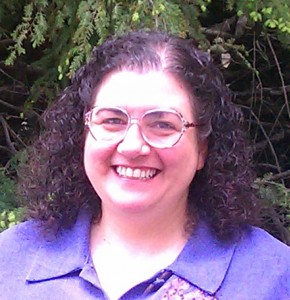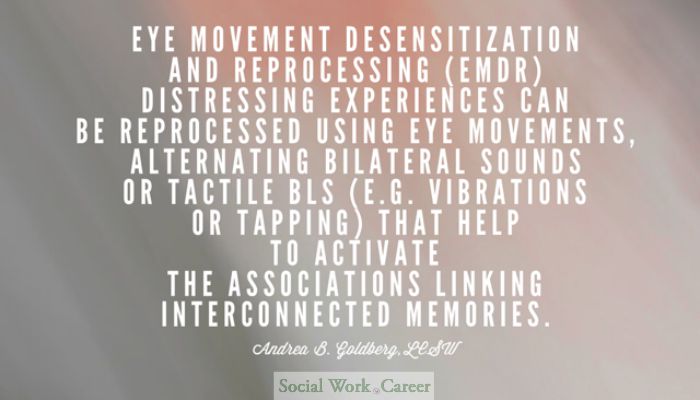Eye Movement Desensitization and Reprocessing (EMDR) therapy is a well-researched, effective therapy method for trauma. This treatment can be combined with traditional “talk” therapy, used as adjunctive treatment with a separate therapist, or as a treatment in of itself.
To find out more information about this method, I interviewed Andrea B. Goldberg, LCSW, who is a clinical social worker with over 25 years of experience as a psychotherapist. She is currently working at an outpatient mental health clinic, as well as in private practice in New Jersey.
Andrea’s trauma expertise includes working with clients with a broad range of incidents such as rape, assault, car accidents, the murder of loved ones and terrorist attacks.
So without further ado, Andrea, what made you decide to become a social worker?
As far back as I can remember, I have wanted to help people. I knew I wanted to be a therapist since I was 9 years old. I entered college studying psychology because I did not know anything about social work. A few things contributed to my change in career from psychology to social work.
First, I was disillusioned with the research orientation of my undergraduate psychology program when I was interested in getting clinical training. Second, I did an internship at a social work agency that introduced me to the profession and helped me to realize how much social work values match my own values.
Can you briefly describe your career trajectory of how you first started out and led you to focus on helping survivors of child abuse and trauma? Also when/how did you start your private practice?
My first job after graduate school was in a child abuse prevention program and that led to my being one of the first therapists in a new sexual abuse treatment program in my county. This is what started my career-long focus on the treatment of trauma.
Private practice came out of a need for more flexibility in my schedule after my daughter was born. Most of my career I have combined private practice with working in a hospital-based mental health clinic. This has given me the best of both worlds.
Can you explain in layman’s terms what is EMDR and how it is a helpful technique to apply with trauma survivors?
EMDR is a method of psychotherapy, developed by Francine Shapiro, that is based on the theory that emotional and behavioral disturbance is often due to traumatic experiences and distressing life events.
These events are so overwhelming that the ability to fully process and gain perspective is blocked. When our adaptive capacities are overwhelmed, EMDR facilitates reprocessing of the traumatic experiences to achieve adaptive resolution.
EMDR starts with history-taking and continues with the development of positive resources to help cope with overwhelming emotions and circumstances.
Then traumatic experiences to target are identified and bilateral stimulation (BLS) is utilized to facilitate the reprocessing of these distressing experiences that block us from optimal functioning.
The core of EMDR treatment involves activating components of the traumatic memory or disturbing life event and pairing those components with alternating BLS.
Distressing experiences can be reprocessed using eye movements, alternating bilateral sounds or tactile BLS (e.g. vibrations or tapping) that help to activate the associations linking interconnected memories.
Once activated, new information about improved capabilities and resources is linked with the distressing life experiences and their emotional, somatic and cognitive impact, to help overcome the unresolved issues that interfere with successful living.
Below is a brief video clip description of EMDR.
Could you describe a case example in which you are applying EMDR with an unidentified and/or fictional client?
Robert (not his real name) had a dentist’s appointment coming up and he was terrified about having to have a novocaine injection. He reported that he was afraid of needles and didn’t know how he was going to be able to go through with it.
The EMDR Institute provides basic training in many cities throughout the country. The training schedule can be found at the following URL: http://www.emdr.com/training-information/us-basic-training-schedule.html. The Institute does not require that trainees have postgraduate experience.
However, in my opinion it is preferable that trainees have some training and experience with trauma treatment. I also believe it is essential for EMDR therapists to receive their own EMDR therapy and get ongoing consultation and training to further develop their skill in this treatment method.
What career advice would you offer to upcoming MSW graduate students who are looking to focus on trauma related social work?
You need to be prepared to bear witness to other people’s pain. If you are not sure you can handle listening to the most horrific experiences you can possibly imagine, then trauma work is not for you.
On the other hand, if you think you can handle this, then it can be the most rewarding work you will ever do.
Finally, what are your thoughts about therapy and social media, be it via skype or through some more innovative modes being considered such as virtual reality like Second Life?
I do not have a lot of experience using social media with clients. I believe that skype could be a very useful tool when clients are unable to make it to the office, but it would not be my first choice because I think something is lost when you are not in the same room with a client.
Visual cues may be limited when the client’s whole body is not visible on skype. There are some somatic strategies that require standing and moving around, which would be hard to keep within view of the webcam, and other somatic techniques can only be done when client and therapist are in physical proximity of each other.
I would also be reluctant to do EMDR reprocessing via skype. Not only would there be technical limitations with most types of bilateral stimulation, but if the client is getting over-aroused by memories, then it is not possible to use touch or scents (such as essential oils) as ways to ground the client.
I do make extensive use of e-mail as a way for clients to contact me in between sessions. Sometimes my clients do journaling in between sessions and are able to share it with me via e-mail. Often, all that is needed is a brief acknowledgment that I’ve received it and read it.
Thanks so much, Andrea, for providing us with this interesting introduction to EMDR treatment!
You can learn more about Andrea by visiting her website www.andreagoldberg.com; you can also follow her on twitter @AndreaGoldberg.
What types of experience have you had with EMDR? What questions or thoughts come to your mind about this type of treatment?




thanks for this post, incredibly helpful! I had heard about EMDR, but really didn’t understand how it was used,
Laura
http://thenudgepatrol.blogspot.com/
Hi Laura,
Thanks for visiting. I’m so glad to hear that you found this post on EMDR helpful.
I thought the case example Andrea gave was particularly helpful in illustrating how EMDR is used.
Hope to see you again soon and I’ll make sure to check out your blog 🙂
Very interesting post…very informative. I have always found EMDR fascinating, although I didn’t know a lot about it. This post offered a very clear and informative introduction….the videos were very helpful and insightful.
I am now inspired to learn even more. I would also like to try EMDR myself to experience it…
Dorlee, your posts are getting better and better! They are substantive and interesting….can’t wait to hear more. Thank you.
I’m so glad you found this post interesting and inspiring…and that you are even now tempted to try EMDR yourself!
Thanks so much, Terry, for your kind feedback 🙂
That said, Andrea was a terrific interviewee – I am but the conduit…
Hi Terry,
I’m glad you are inspired to learn more about EMDR. You might want to read the book
EMDR: The Breakthrough “Eye Movement” Therapy for Overcoming Anxiety, Stress, and Trauma by Francine Shapiro and Margot Silk Forrest. It was published by Basic Books in 1998 and is written in non-technical language that everyone can understand. It is the book I read when I wanted to learn more before I pursued EMDR training.
If you want further information about EMDR therapy, feel free to contact me. My contact information is on my website.
Warmly,
Andrea
It’s interesting that many people are benefitted by this. Watching the lights in the 2nd video, I found them irritating & distracting. Just remember that not every client will respond well to EMDR, though I do want to get myself acclimated to this method. I’m preparing for my LMSW exam. I may need this information for the test, but more importantly, I may have a client in the future who will benefit from it. Thank you for posting this.
Hi,
You are absolutely right in that not every client will respond well to EMDR (or in that it may not be appropriate for every client).
By the way, I too would not be able to tolerate the lights method of EMDR; however, there are other ways one may provide or receive the benefits of EMDR. For example, one may receive the stimulation via the hands (and this skips the use of lights or eyes entirely).
Some people use the hand stimulation method slightly differently by placing the tools under the legs (so that they do not need to hold them) and then the vibrations are turned on and the client feels a vibration first under the right leg and then under the left leg. Another way could even be to insert those little pads into one’s sneakers. In short, EMDR may be provided in many more ways than just the light and/or eye methods to be beneficial.
Wishing you the best of luck on your exam!